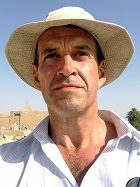Bill Manley is an Egyptologist and Coptic scholar, who teaches at the University of Glasgow and has worked with archaeological projects in Egypt and Palestine for more than two decades.
His output includes textbooks, catalogues, scholarly articles and museum exhibitions, covering subjects as diverse as ancient language and texts, art and jewellery, the history of Egyptology, and the world’s oldest philosophy.
He has also spoken at international book festivals, including The Sunday Times Literary Festival. Bill is Honorary President of Egyptology Scotland, Co-Director of Egiptología Complutense, and a contributor to the Coptic Magical Papyri Project.
He lives in Renfrewshire and has been a member of the Society of Authors since 2017.


